I got Jesse from the pound in Atlanta in 1979 when I was bumming around after quitting work at the Augusta newspaper (That was the second time; that time it took, and I never went back.) Her cage had a sign identifying her as a Dalmatian named Sugar who was not good with children. She wasn’t a Dalmatian. I think she was mostly some kind of birddog. She was too smart to be a Dalmatian. She was not “Sugar”. There was no way I was going to step outside and scream, “SUGAR!!!” So she became Jesse. And I suspect that it was kids who were not good with her.
She went everywhere with me. When I brought her home to my parents’, she came inside with me, the first dog ever allowed to stay inside my mother’s house. When I decided to go to graduate school at Georgia Tech, a requirement for finding a place to stay was that dogs be allowed.
She was good company, much better, in fact, than any roommate I had while at Tech. Every day when I came home I changed clothes and walked her a couple of blocks to a vacant area where I could let her run free for an hour or so.
I ran too, but it didn’t relieve all the stress.
Graduate school is stressful. My brother, who also got his PhD from Georgia Tech, said several times he thought he just couldn’t take any more, so he went home and started packing. Me, too. Graduate school is like working full time and going to school full time. Coursework means you always take your work home with you, or, most likely, don’t go home until all the work is done.
School was not the only source of stress. I lived about three blocks from I-75. There was a railroad line just behind the houses across the street from where I lived. Jets flew over all the time to Hartsfield or to one of the local airports. The noise was constant: cars, trucks, trains, airplanes. Sometimes I would stand in the driveway and listen, and think, if I don’t get away from this noise I am going to go freaking crazy.
So on some weekends I would drive up to northeast Georgia where there were several places to access the Appalachian Trail. Saturday mornings I would pack my stuff, load Jesse into the car and drive a couple of hours to a trail crossing. I would walk into the woods at a leisurely pace, stop somewhere for lunch, walk on a bit and find a nice, level campsite not too far off the trail. We spent the night and then walked back to the car on Sunday morning. A lot of people consider backpacking a competitive sport. Their goal is miles. My goal was to get away from things for a while, so I almost never went more than six miles or so along the trail.
Jesse probably ran two or three miles for every mile I walked. She was kind of like our current dog Zeke, who runs wild when he’s off the leash. But Jesse was reliable; she always came back. She kept track of me. She would run off ahead of me, and then after a while, come running back to me and take off in the opposite direction. Sometimes she would disappear ahead of me and then show up behind me. She was always orbiting me.
I loved those hikes.
It took me five and a half years to finish at Tech. I went to work in Huntsville, Alabama, in June 1986. I still occasionally went backpacking in Georgia, but it was a considerably longer drive. I don’t think my father ever went hiking with me when I was at Tech, but he did after I graduated. These pictures are from a hike we made in the fall of 1987. My father was 70 years old then. He looked damned good, and he managed the hikes at least as well as I did. All of these pictures are scanned from my old 35 mm slides.
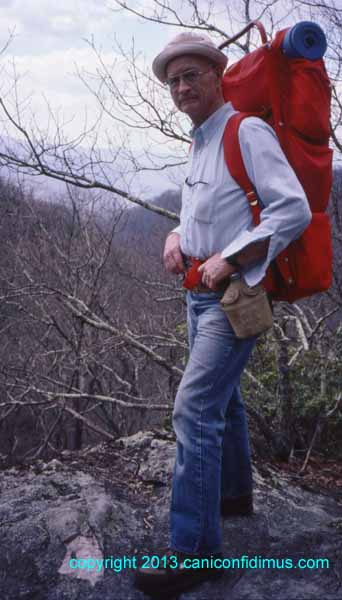
BD at an overlook. Look at the old Army canteen.
About “BD”. My brother and I called our father Daddy. Apparently as very small boys we started calling him Pop, but he objected, so he became Daddy from then on. Our mother was Mother, but our father was Daddy. At some time many years ago, we started calling him Big Daddy. I don’t know where it came from, or even exactly when it started. I must have been pretty young. “Big Daddy” became “BD”. Long after we had grown up, if we ever had to write a note to him to leave on the kitchen counter, we addressed it to BD. My brother got him a black baseball cap with BD embroidered in yellow. We still have that cap somewhere.
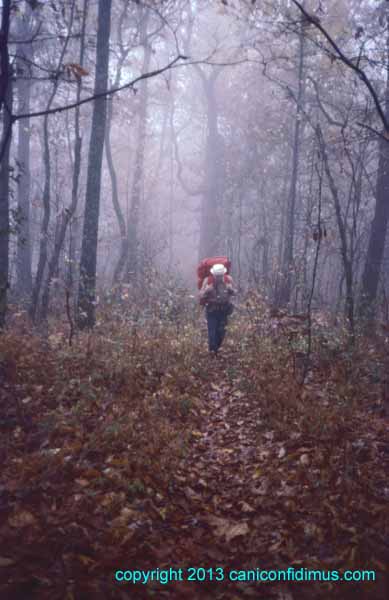
On the trail
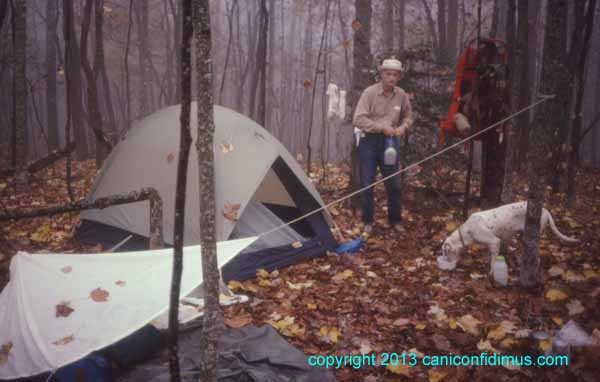
Setting up camp. Jesse is thirsty.
On this particular hike, we lost Jesse for a while. We had been walking when we realized that we hadn’t seen her for a long time. It was odd, because she usually checked in with us every 20 or 30 minutes. So we stopped to wait for her. We called some, but mainly just waited. I was pretty confident that she would find us if she was able to move, because I had already had some experience with her scenting ability.
So we sat and waited. I don’t remember how long it took, but she eventually showed up. She was very tired. I think she might have come back to the trail and somehow decided to go back towards the car. I think she ran all the way back to the car, saw we weren’t there, and then turned around and ran back to us. I don’t know that for sure, but that’s always been what I thought.
Another thing I have thought all these years is that Jesse had caught and killed something. I saw the blood on the side of her face and assumed it was from another animal. It was only recently that I had reason to rethink that. As I posted before, on one of Zeke’s unauthorized, wild romps through the woods, he snagged one of his ears on something and the flopping ear left blood all over the side of his face within the radius of his ear. If you look at Jesse’s face, you can see a similar pattern. Her ears were longer than Zeke’s, so it left a bigger trace. So, after all these years, I finally know that Jesse didn’t kill something, she just snagged her ear. Not that she never killed anything; she was pure hell on possums. But not this time.
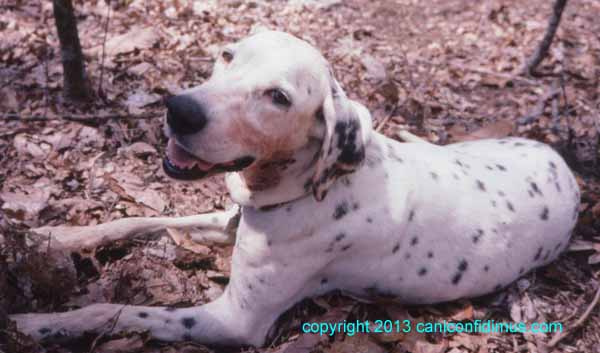
Jesse, recovering, with blood from her ear
I guess it was not long after this that I took another hike with Jesse. She did her usual wild running, but this time it was different. We were about a mile from the car on our way back on Sunday when she ran up behind me, came around ahead of me and laid down across the trail. The message couldn’t have been clearer: she needed to rest. I sat down and gave her a while to recover. Then I said, “Come on, Jesse, let’s go.” She got up, walked about 20 feet, then laid down again. This time I had to make her get up. We had to get back to the car, and I knew she could rest as long as she wanted once she got into the back seat.
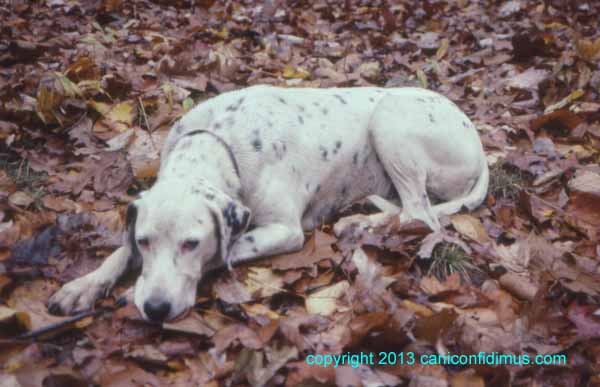
Jesse, at rest
I thought she was tired because she had not been getting as much exercise as she used to, and she was at least eight years old. Now I think she must have already had the cancer that killed her the next year.
When I look at these pictures of Jesse I feel a strong urge to reach out and stroke her knotty head. I would always put my hand on her head and scratch it. Sometimes she closed her eyes when I did that.
I could physically feel her head under my hand for years after she died.
I can still feel it if I try.